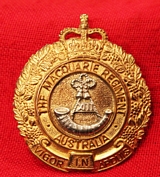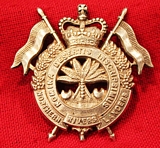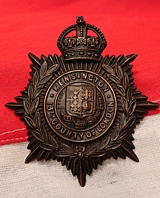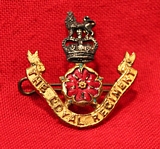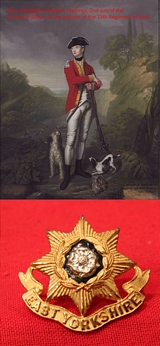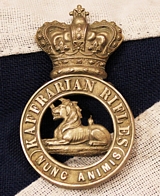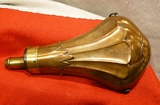13th Battalion (The Macquarie Regiment) - Bi Metal Hat Badge 1953 - 60
13th Battalion (The Macquarie Regiment) - Bi Metal Hat Badge 1953 - 60. Complete with two lugs. The 13th Battalion was an infantry battalion of the Australian Army. Originally raised for the 1st Australian Imperial Force during the First World War, it was formed just six weeks after the start of the war. Along with the 14th, 15th and 16th Battalions which were recruited from New South Wales, it formed the 4th Brigade. The battalion saw service initially at Gallipoli before being transferred to France in 1916. For the next two years it fought in the trenches of the Western Front, earning numerous battle honours in the process.
Following the end of the war, the 13th Battalion was demobilised in early 1919. It was re-raised in 1921 as a unit of the part-time Citizens Force, based around Maitland, New South Wales. During the Second World War the battalion undertook garrison duties before being amalgamated with the 33rd Battalion in October 1942. It was re-raised for a third and final time sometime after 1948 and remained on the order of battle until 1960 when it was subsumed into the Royal New South Wales Regiment. read more
90.00 GBP
Northern River Lancers - White Metal Hat Badge 1953 - 56
The 15th Northern River Lancers was an amphibious assault squadron of the Australian Army, the Lancers were designated 'A' Squadron, Amphibious Assault Regiment. The 15th Northern River Lancers were formed in 1948 and based in Northern New South Wales, in 1956 it was amalgamated with the 1st Royal New South Wales Lancers to become 1st/15th Royal New South Wales Lancers. read more
110.00 GBP
George Vth 13th County of London Kensington Helmet Plate
Excellent condition. It was first formed in 1908 in order to regiment the 26 Volunteer Force battalions in the newly formed County of London, each battalion having a distinctive uniform.
Now part of the Territorial Force, the London Regiment expanded to 88 battalions in the First World War. Of these 49 battalions saw action in France and Flanders, 6 saw action at the Gallipoli Campaign, 12 saw action at Salonika, 14 saw action against the Turks in Palestine, and one saw action in Waziristan and Afghanistan.
The London Regiment ceased to exist in 1938 and the battalions transferred to regular infantry regiments, the Royal Artillery and the Royal Engineers. read more
165.00 GBP
A Very Good Officer's Silver and Gilt Cap Badge of the Loyal Regt. the Lancashire 1950's.
Original early ERII. With red rose centre and gilt regimental banner. Silver crowned lion. 2 part construction. At the outbreak of World War II, the 1st Battalion Loyals were part of the 2nd Infantry Brigade, attached to the 1st Infantry Division. In September 1939 they were sent to France as part of the British Expeditionary Force and remained there alongside the French Army until May 1940. The 1st Loyals would participate in the fighting in France and Belgium in 1940, including acting as part of the rearguard for the Dunkirk evacuation. Eventually, the 1st Loyals would see action in Tunisia in early 1943, and Italy and at the Battle of Anzio where the 1st Division saw some of the fiercest fighting of the war. The battalion along with the rest of 1st Division were sent to Palestine in 1945. During the fighting in the Tunisian campaign, in April 1943, Lieutenant Willward Alexander Sandys-Clarke was posthumously awarded the regiment's only Victoria Cross of the war for his extreme heroism.
Upon the commencement of hostilities in 1939, the 2nd Battalion, Loyal Regiment found themselves stationed in the Far East as part of Singapore Fortress's 1st Malaya Infantry Brigade. After the Japanese attack on Pearl Harbor, the 2nd Loyals fought in Malaya as part of the delaying action during the Battle of Malaya. Eventually, the 2nd Battalion surrendered along with the rest of the Singapore garrison on 15 February 1942. The survivors spent the rest of the war as prisoners of the Imperial Japanese Army.
Following the destruction of the 2nd Loyals with its surrender at Singapore, the battalion was reformed in Britain. The 10th Battalion, a hostilities-only battalion raised in 1940, was re-designated as the new 2nd Battalion on 28 May 1942. Eventually the battalion was deployed as part of 20th Indian Infantry Brigade of the 10th Indian Infantry Division in Italy during the closing phases of the Italian Campaign read more
55.00 GBP
A Very Fine East Yorkshire Regt. Officer's Cap badge
In gilt silver and enamel . Two fixing lugs. Raised in 1685 in Nottingham by Sir William Clifton, 3rd Baronet, it was originally, like many British infantry regiments, known by the name of its current Colonel. In 1751, when the numerical system of designation of Regiments of Foot was adopted, it became the 15th Regiment of Foot and in 1782 the 15th (The Yorkshire East Riding) Regiment of Foot. With the Childers Reforms of 1881, it became The East Yorkshire Regiment, the County Regiment of the East Riding of Yorkshire, and in 1935 was renamed The East Yorkshire Regiment (The Duke of York's Own), after its Colonel-in-Chief. In 1958, it was amalgamated with The West Yorkshire Regiment (The Prince of Wales's Own), to form The Prince of Wales's Own Regiment of Yorkshire.
It fought in the War of Spanish Succession, the Jacobite Rising of 1719 and in North America and the West Indies during the War of Jenkin's Ear, Seven Years' War and the American Revolutionary War including battles such as Capture of St. Lucia in 1778. It again fought in the West Indies during the Napoleonic Wars, taking part in the invasions of Martinique (1809) and Guadeloupe (1810).
The regiment spent most of the 19th century on garrison duty, both at home and throughout the Empire. The 1st Battalion was shipped to New Brunswick in 1862 at the time of the "Trent Affair", when Britain and the United States of America came close to war. The 2nd Battalion fought in the Second Anglo-Afghan War and the Second Boer War. Battle honours
Regimental colours; Blenheim, Ramillies, Oudenarde, Malplaquet, Louisburg, Quebec 1759, Martinique 1762, Havannah, St. Lucia 1778, Martinique 1794 1809, Guadeloupe 1810, Afghanistan 1879-80, South Africa 1900-02, The Great War (21 battalions): Aisne 1914 '18, Armenti?res 1914, Ypres 1915 '17 '18, Gravenstafel, St. Julien, Frezenberg, Bellewaarde, Hooge 1915, Loos, Somme 1916 '18, Albert 1916 '18, Bazentin, Delville Wood, Pozi?res, Flers-Courcelette, Morval, Thiepval, Ancre Heights, Ancre 1916, Arras 1917 '18, Scarpe 1917 '18, Arleux, Oppy, Messines 1917 '18, Pilckem, Langemarck 1917, Menin Road, Polygon Wood, Broodseinde, Poelcappelle, Passchendaele, Cambrai 1917 '18, St. Quentin, Bapaume 1918, Rosi?res, Lys, Estaires, Hazebrouck, Kemmel, Scherpenberg, Amiens, Hindenburg Line, ?p?hy, Canal du Nord, St. Quentin Canal, Selle, Sambre, France and Flanders 1914-18, Struma, Doiran 1917, Macedonia 1915-18, Suvla, Landing at Suvla, Scimitar Hill, Gallipoli 1915, Egypt 1915-16
The Second World War: Withdrawal to Escaut, Defence of Escaut, Defence of Arras, French Frontier 1940, Ypres-Comines Canal, Dunkirk 1940, Normandy Landing, Tilly sur Seulles, Odon, Caen, Bourgu?bus Ridge, Troarn, Mont Pincon, St. Pierre la Vielle, Gheel, Nederrijn, Aam, Venraij, Rhineland, Schaddenhof, Brinkum, Bremen, North-West Europe 1940 '44-45, Gazala, Mersa Matruh, Defence of Alamein Line, El Alamein, Mareth, Wadi Zigzaou, Akarit, North Africa 1942-43, Primosole Bridge, Sicily 1943, Sittang 1945, Burma 1945 read more
95.00 GBP
A Victorian Kaffrarian Rifles Badge, of South Africa, Motto "Nunc animus"
Nunc animus (meaning "Now with courage" or "Now without fear") This unit was formed in East London in 1876, as the Buffalo Corps of Rifle Volunteers, for service in the 9th Frontier War. It disbanded in 1879. (East London is situated on the Buffalo River, hence the name).
The unit was re-formed in July 1883 and was named after the region of Kaffraria, the 19th-century name for the region around East London. There had previously been many other units from this region, from which the Regiment can also claim descent: Kaffrarian Volunteer Corps, Kaffrarian Mounted Rifles (Kaffrarian Rangers), Buffalo Volunteer Rifles Corps, Buffalo Volunteer Engineers, Kaffrarian Volunteer Artillery Corps, Berlin Mounted Volunteers, Cape Mounted Yeomanry (1st Regiment), Frontier Mounted Riflemen (Brabant's Horse), East London Volunteers (Von Linsignen's Buffalo Corps and later Walkers Horse).
On 1 December 1900 George Herbert Farrar was appointed as a Major in the Kaffrarian Rifles.
In 1913 it was embodied in the Citizen Force as the 5th Infantry (Kaffrarian Rifles), but regained its old name in 1932. The unit was temporarily amalgamated with the First City Regiment, as the First City/The Kaffrarian Rifles from 1954 to 1956. In order to keep pace with the changing political climate in South Africa, the regiment was renamed the Buffalo Volunteer Rifles in 1999.
This Regiment and its predecessors took part in all of South Africa's armed conflicts, including the Bechuanaland Campaign (1897), the Second Boer War, World War I (when it fought in the then German South-West Africa and most of its members went on to serve in East Africa and Europe), World War II (when it fought in the Western Desert during 1941 - 1943 . 62 mm high read more
95.00 GBP
WW2 Period Chinese Bank of Communications 25-Yuan Note,
1941, serial no. 784417 green, electric direct
current generator, Zeppelin and plane at centre. Established in 1908, Bank of Communication claims a long history in China and is one of the banks to have issued banknotes in modern Chinese history. read more
45.00 GBP
A Good 19th Century Powder Flask
Fluted copper body and brass adjustable spout. read more
175.00 GBP
A Good 19th Century Sykes Pistol Powder Flask
Absolutely ideal for pistol casing. A nice example with a few small dents. Small pistol flasks are certainly the most desireable type as they can beautifully set off a cased pistol set [and thus increase it's value dramatically], for either a flintlock or percussion gun, that is lacking it's original flask. 4.5 inches long read more
295.00 GBP
A Very Nice 19th Century Dixon & Son Pistol Powder Flask
In nice order with working spring spout with three adjustable gram measures. 4.75 inches long overall. A delightful piece with pressed shell pattern in copper with gilt spout. Super patina. read more
340.00 GBP


